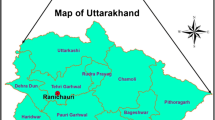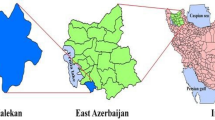Abstract
Estimation of evaporation is of indispensable significance for management and development of water resources. This study aims to identify the suitability of hybridizing the Cuckoo optimization algorithm (COA) with two well-known approaches of artificial neural networks (ANN) and adaptive neuro-fuzzy inference system (ANFIS) for prediction of daily pan evaporation. For this aim, two hybrid models of ANN–COA and ANFIS–COA are developed and their performances are compared with single ANN and ANFIS. As case study, the daily climate parameters including the average air temperature (T avg), sunshine hours (S), relative humidity (R h ), wind speed (W) and pan evaporation (E) measured and collected for three Iranian stations of Zabol, Iranshahr and Shiraz have been utilized. The used data sets are divided into three parts so that 60, 20 and 20 % of the data are applied for training, testing and prediction phases, respectively. The achieved results prove that the models’ performances are variable among cities. It is found that combining the COA with ANN and ANFIS techniques does not enhance the precision of the developed ANN and ANFIS models noticeably in all considered stations. In fact, the results demonstrate that hybridizing the COA with ANN and ANFIS cannot be a viable option for estimation of daily evaporation. Overall, the study results indicate that further accuracy can generally be achieved by the ANN model; consequently, the ANN model can be sufficiently used in the prediction of daily evaporation.





Similar content being viewed by others
Change history
20 December 2018
The Editors-in-Chief of Environmental Earth Sciences are issuing an editorial expression of concern.
References
Angstrom A (1924) Solar and terrestrial radiation. Q J R Meteorol Soc 50:121–126
Antonellini M, Dentinho T, Khattabi A, Masson E, Mollema PN, Silva V et al (2014) An integrated methodology to assess future water resources under land use and climate change: an application to the Tahadart drainage basin (Morocco) environmental. Earth Sci 71:1839–1853
Aziz A, Wong K (1992) Neural-network approach to the determination of aquifer parameters. Ground Water GRWAAP 30:164–166
Balkhair K (2002) Aquifer parameters determination for large diameter wells using neural network approach. J Hydrol 265:118–128
Behnasr M, Jazayeri-Rad H (2015) Robust data-driven soft sensor based on iteratively weighted least squares support vector regression optimized by the cuckoo optimization algorithm. J Nat Gas Sci Eng 22:35–41
Benzaghta MA, Mohammed TA, Ghazali AH, Mohd Soom MA (2012) Validation of selected models for evaporation estimation from reservoirs located in arid and semi-arid regions. Arab J Sci Eng 37:521–534
Berrazouane S, Mohammedi K (2014) Parameter optimization via cuckoo optimization algorithm of fuzzy controller for energy management of a hybrid power system. Energy Convers Manag 78:652–660
Bhandari AK, Singh AK, Kumar A, Singh GK (2014) Cuckoo search algorithm and wind driven optimization based study of satellite image segmentation for multilevel thresholding using Kapur’s entropy. Expert Syst Appl 41:3538–3560
Chau K (2007) Reliability and performance-based design by artificial neural network. Adv Eng Softw 38:145–149
Doorenbos J, Pruitt WO (1977) Guidelines for predicting crop water requirements, 2nd edn. Irrigation and drainage paper no. 24, FAO, Rome
Eslamian SS, Gohari SA, Biabanaki M, Malekian R (2008) Estimation of monthly pan evaporation using artificial neural networks and support vector machines. J Appl Sci 8(19):3497–3502
Guven A, Kisi O (2011) Daily pan evaporation modeling using linear genetic programming technique. Irrig Sci 29:135–145
Hernandez EA, Uddameri V (2014) Standardized precipitation evaporation index (SPEI) based drought assessment in semiarid south Texas. Environ Earth Sci 71:2491–2501
Ikebuchi S, Seki M, Ohtoh A (1988) Evaporation from Lake Biwa. J Hydrol 102:427–449
Irmak S, Allen RG, Whitty EB (2003) Daily grass and alfalfa reference evapotranspiration estimates and alfalfa-to-grass evapotranspiration ratios in Florida. J Irrig Drain Eng 129(5):360–370
Jang JSR (1993) ANFIS: adaptive-network-based fuzzy inference systems. IEEE Trans Syst Man Cyber 23:665–685
Kavousi-Fard A, Samet H, Marzbani F (2014) A new hybrid modified firefly algorithm and support vector regression model for accurate short term load forecasting. Expert Syst Appl 41:6047–6056
Keskin ME, Terzi Ö, Taylan D (2009) Estimating daily pan evaporation using adaptive neural-based fuzzy inference system. Theor Appl Climatol 98:79–87
Khajeh M, Golzary AR (2014) Synthesis of zinc oxide nanoparticles–chitosan for extraction of methyl orange from water samples: cuckoo optimization algorithm–artificial neural network. Spectrochim Acta Part A Mol Biomol Spectrosc 131:189–194
Khajeh M, Jahanbin E (2014) Application of cuckoo optimization algorithm–artificial neural network method of zinc oxide nanoparticles–chitosan for extraction of uranium from water samples. Chemometr Intell Lab Syst 135:70–75
Kisi O (2009) Modeling monthly evaporation using two different neural computing techniques. Irrig Sci 27:417–430
Kisi O (2013) Evolutionary neural networks for monthly pan evaporation modelling. J Hydrol 498(19):36–45
Kisi O, Cimen M (2012) Precipitation forecasting by using wavelet-support vector machine conjunction model. Eng Appl Artif Intell 25:783–792
Liang RP, Huang SY, Shi SP, Sun XY, Suo SB, Qiu JD (2012) A novel algorithm combining support vector machine with the discrete wavelet transform for the prediction of protein sub cellular localization. Comput Biol Med 42:180–187
Ma Q, Zhang MJ, Wang SJ, Wang Q, Liu WL, Li F (2014) An investigation of moisture sources and secondary evaporation in Lanzhou, Northwest China. Environ Earth Sci 71:3375–3385
McCuen RH (1998) Hydrologic analysis and design. Prentice Hall, Englewood Cliffs
Moghaddamnia A, Ghafari Gousheh M, Piri J, Amin S, Han D (2009) Evaporation estimation using artificial neural networks and adaptive neuro-fuzzy inference system techniques. Adv Water Resour 32(1):88–97
Molga M, Smutnicki C (2005) Test functions for optimization needs
Olatomiwa L, Mekhilef S, Shamshirband S, Mohammadi K, Petkovic D, Sudheer C (2015) A support vector machine–firefly algorithm-based model for global solar radiation prediction. Sol Energy 115:632–644
Partal T, Kisi O (2007) Wavelet and neuro-fuzzy conjunction model for precipitation forecasting. J Hydrol 342:199–212
Patwardhan AP, Patidar R, George NV (2014) On a cuckoo search optimization approach towards feedback system identification. Digit Signal Proc 32:156–163
Payne RB, Sorenson MD, Klitz K (2005) The cuckoos. Oxford University Press, Oxford
Piri J, Ansari H (2012) Daily pan evaporation modelling with ANFIS and NNARX. Iran Agric Res 31:51–64
Piri J, Amin S, Moghaddamnia A, Han D, Remesun D (2009) Daily pan evaporation modelling in hot and dry climate. J Hydrol Eng 14:803–811
Rajabioun R (2011) Cuckoo optimization algorithm. Appl Soft Comput 11:5508–5518
Rehman S, Mohandes M (2008) Artificial neural network estimation of global solar radiation using air temperature and relative humidity. Energy Policy 36:571–576
Saidi H, Ciampittiello M, Dresti C, Turconi L (2015) Extreme rainfall events: evaluation with different instruments and measurement reliability. Environ Earth Sci 72:4607–4616
Sanikhani H, Kisi O, Nikpour MR, Dinpashoh Y (2012) Estimation of daily pan evaporation using two different adaptive neuro-fuzzy computing techniques. Water Resour Manag 26:4347–4365
Schalkoff RJ (1997) Artificial neural networks. McGraw-Hill Higher Education, New York
Shamshirband S, Gocić M, Petković D, Saboohi H, Herawan T, Mat Kiah ML, Akib S (2015a) Soft-computing methodologies for precipitation estimation: a case study. IEEE J Sel Topics Appl Earth Obs Remote Sens 8(3):1353–1358. doi:10.1109/JSTARS.2014.2364075
Shamshirband S, Petković D, Pavlović NT, Sudheer C, Torki A, Altameem TA, Gani A (2015b) Support vector machine firefly algorithm based optimization of lens system. Appl Opt 54:37–45
Shamshirband S, Mohammadi K, Khorasanizadeh H, Yee PL, Lee M, Petković D, Zalnezhad E (2016) Estimating the diffuse solar radiation using a coupled support vector machine–wavelet transform model. Renew Sustain Energy Rev 56:428–435
Shirsath PB, Singh AK (2010) A comparative study of daily pan evaporation estimation using ANN, regression and climate based models. Water Resour Manag 24:1571–1581
Shrivastava NA, Panigrahi BK (2014) A hybrid wavelet-ELM based short term price forecasting for electricity Markets. Electr Power Energy Syst 55:41–50
Sudheer KP, Gosain AK, Rangan D, Saheb SM (2002) Modeling evaporation using an artificial neural network algorithm. Hydrol Process 16:3189–3202
Sudheer C, Sohani SK, Kumar D, Malik A, Chahar BR, Nema AK et al (2014) A Support vector machine-firefly algorithm based forecasting model to determine malaria transmission. Neurocomputing 129:279–288
Tabari H, Marofi S, Sabziparvar AK (2010) Estimation of daily pan evaporation using artificial neural network and multivariate non-linear regression. Irrig Sci 28:399–406
Terzi O (2013) Daily pan evaporation estimation using gene expression programming and adaptive neural-based fuzzy inference system. Neural Comput Appl 23:1035–1044
Terzi O, Keskin ME (2005) Modelling of daily pan evaporation. J Appl Sci 5(2):368–372
Xiong T, Bao Y, Hu Z (2014) Multiple-output support vector regression with a firefly algorithm for interval-valued stock price index forecasting. Knowl Based Syst 55:87–100
Yang XS (2010) Engineering optimisation: an introduction with meta-heuristic applications. Wiley, New York
Yang XS, Deb S (2009) Cuckoo search via Lévy flights. In: World congress on nature & biologically inspired computing (NaBIC2009). IEEE publications 210–214
Yang XS, Deb S (2013) Multi objective cuckoo search for design optimization. Comput Oper Res 40:1616–1624
Yanga K, Koikea T, Yeb B (2006) Improving estimation of hourly, daily and monthly solar radiation by importing global data sets. Agric For Meteorol 137:43–55
Acknowledgments
The authors express their sincere thanks for the funding support they received from HIR-MOHE University of Malaya under Grant no. UM.C/HIR/MOHE/ENG/34.
Author information
Authors and Affiliations
Corresponding author
Rights and permissions
About this article
Cite this article
Piri, J., Mohammadi, K., Shamshirband, S. et al. Assessing the suitability of hybridizing the Cuckoo optimization algorithm with ANN and ANFIS techniques to predict daily evaporation. Environ Earth Sci 75, 246 (2016). https://doi.org/10.1007/s12665-015-5058-3
Received:
Accepted:
Published:
DOI: https://doi.org/10.1007/s12665-015-5058-3




